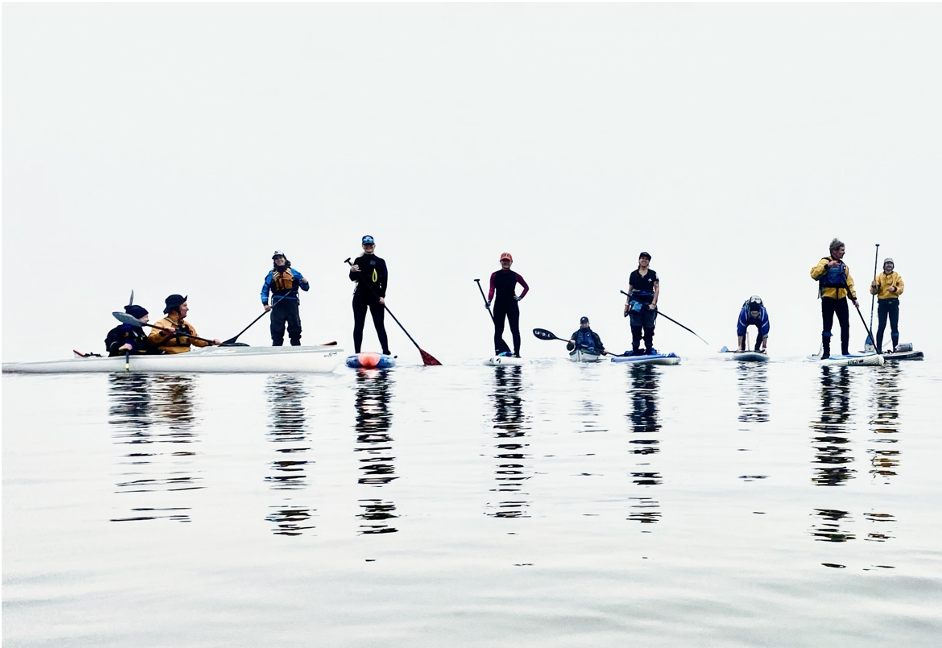Cold Season Paddlers: Tips and Advice

Want to Kayak or Paddleboard After Summer?
Cold season paddling can be a glorious joy! There’s a lack of traffic, unique angle of the light, and a sense you’re a step closer to a primal reality. That’s why MKC offers it. Fresh air and blue water creates a wonderful heart-nurturing exercise. Connecting to nature via water can ease our souls. Read about the Blue Mind. However, paddling in the cold requires awareness, preparation, and respect.
Be Aware of Temperatures
We are very aware of shorter daylight hours, wind, and temperatures because of the high risk of Hypothermia and Cold Shock. As a result, paddlers follow this rule of thumb: add air temp + water temp – wind chill. If the sum is 120 Fahrenheit or less, paddlers must wear special cold water gear. On an average autumn day, it’s 45 + 55 – 5 = 95. Below a value of 80, we recommend not paddling! This is common in January and February.
Paddlers should consult our Weather and Tides page. Paddlers are much more vulnerable to weather than other vessels. Read more about how wind speed affects your paddling. Strong wind makes bigger waves and bigger waves can lead to capsizing. Wind can turn a 1-hour trip into 2 hours or more.
Create Your Float Plan Ahead
Those of you who paddle in the Hudson River are surely aware of the tidal currents. Going with them is easy and going against is difficult, so it’s essential to plan right. Our standard go-to is Eldridge’s Tide Book, NOAA’s Battery tide time tables, and the Stevens Institute’s real-time map of NYC’s tidal currents.
Our general rule of thumb is to paddle AGAINST the current for a short paddle (1-2 hours) so you can come back home with the current. For longer trips, plan to have favorable currents in both directions. Ride the flood – when water flows north from the ocean – and the ebb – when water retreats south to the ocean.
High tide at the Battery means the flood is at top strength ~3 knots at the boathouse. 2.5 hours after high tide, the river is slack. 3.5 hours after slack, it’s low tide and the ebb’s at top strength ~4.5 knots. 3.5 hours after low, the river is slack again and soon turns north. 2.5 hours after slack, it’s high tide again and the flood’s at top strength once more.
In general, the ebb current is longer in duration and stronger in velocity than the flood. The full and new moons make both currents even stronger.
When the ebb meets a strong north wind, the river becomes a field of white-capped waves. SURF’S UP! Skilled paddlers can have a great time surfing up-current with the wind, then get a fast ride back. SUPers: Here’s a beginner’s video on downwind SUP surfing and a tutorial from Chase Kosterlitz.
What To Wear For Cool and Cold Weather Paddling
Be prepared to be stranded from your paddle, boat, or both with no rescuers nearby. If you are not ready to buy your own gear for the Autumn season, borrow MKC’s PFDs, Farmer Johns/Janes, splash jackets, and booties, but still bring your own insulated top, thick wool socks, neoprene gloves, and a hat.
What To Wear On Your Body
Proper cold water layering is essential. Wear high visibility colors and never cotton! Start by choosing your outer layer. From December to May, Kokatat’s drysuits are the gold standard for cold water kayakers. SUPers need suits with more range of motion, like StarBoard’s AllStar drysuit or Ocean Rodeo’s Heat drysuit. Paddlers must wear insulating top and bottom layers under any drysuit to be warm.
Wetsuits are a more affordable alternative for use in the Autumn season. A 3mm Farmer John/Jane wetsuit plus a long-sleeve insulating top and splash jacket is a more comfortable versatile combination than a full-sleeved wetsuit. Always wear a full-torso PFD.
What To Wear On Your Head
Head, hands, and feet are the oft overlooked trio of comfort. Have a comfortable, warm-when-wet, over-the-ears hat or balaclava.
What To Wear On Your Hands
Kayakers can wear a light neoprene glove with Pogies on top. Make sure the Pogie wrist band is not too tight so you can layer the gloves under. SUPers can wear waterproof snowmobile mittens.
What To Wear On Your Feet
I swear by 7mm neoprene high-top zip booties like NeoSports with room for my thick socks inside, for both kayak and SUP. My favorite socks in and out of the water are merino wool People Socks.
Communicate With Other Boats
If you’re paddling without a guide, bring a fully charged VHF marine radio and whistle connected to your PFD, your phone in a waterproof case, and a charged waterproof headlamp or light if there’s a chance of being out near dark. Use Channel 13 for commercial traffic and Channel 16 for distress and emergencies. Use radio protocols. The product protection plan on this West Marine radio is worth it!
Stay Hydrated
For a short paddle, bring a quart of water and easy-to-open energy bars. Be mindful of over hydrating – jumping out to pee is not an option. Much can be said for a good “relief” zipper on your drysuit.
Know Your Rescues
Be able to self-rescue and be paddle fit from lots of recent trips. Be able to get in/out of the boat alone and, for kayakers, put on a spray cover with cold hands. I heartily recommend yoga and pilates – the extra flexibility will grant you wonderful benefits in the cold weather.
Paddle With A Partner
It’s best that you join the weekend groups whether you own your boat or not. Weekend groups won’t go out if the day’s air temp + water temp – wind chill is lower than 80! The après paddle pow-wow’s with a warm mug of coffee, hot chocolate, or matcha with a shared sense of adventure are a reward all on their own. But, if you must paddle at a different time, then we heartily recommend going with a skilled and prepared buddy. Two is better than one, and three is even better.
For Die-Hard Soloists
If you must go solo, use top quality gear and your own sea-worthy vessel. Go when there’s less wind and stick to short distances. Prepare your float plan ahead and be confident that you can execute a self-rescue. If you can’t do this, never go alone.
